

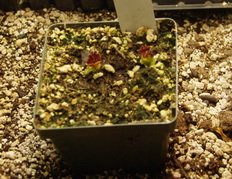
Cordelia is alive. My wonderful Tuberous Begonia is putting up a couple of shoots. The cutting I took from it last fall is doing very well as I showed you a while ago but the overwintered tuber was very sad and shrivelled looking. I planted it anyway, with large amounts of hope and faith and this week two shoots have emerged from the pot. Can it be just coincidence that its resurrection became obvious on Easter weekend. The ability of plants to struggle and survive is always a miracle to me. 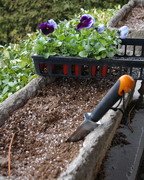 It’s nice that I am having such success indoors because our very late and wet spring is certainly making sure that I spend lots of time there. If this keeps up I may even have time to build the new book shelves in the living room that the Assistant Gardener has been suggesting since that room was redecorated a couple of months ago. We have had snow at least twice this April; not enough to really accumulate just enough to really annoy. I haven’t even been to the garden centre to get some Pansies to plant in the front porch containers. These boxes usually give me two good colour rotations each year with hot season flowers like Impatiens following the cool Pansies which are usually planted in early April. Well maybe this week. Trying desperately to get the front yard raked, edged, mulched and tidy looking so that the hundreds of bulbs that are already blooming and will continue to do so for a few weeks, look their best. A magazine photo shoot is coming, in a week or so, and at this rate their won’t be a single Tulip in bloom.
It’s nice that I am having such success indoors because our very late and wet spring is certainly making sure that I spend lots of time there. If this keeps up I may even have time to build the new book shelves in the living room that the Assistant Gardener has been suggesting since that room was redecorated a couple of months ago. We have had snow at least twice this April; not enough to really accumulate just enough to really annoy. I haven’t even been to the garden centre to get some Pansies to plant in the front porch containers. These boxes usually give me two good colour rotations each year with hot season flowers like Impatiens following the cool Pansies which are usually planted in early April. Well maybe this week. Trying desperately to get the front yard raked, edged, mulched and tidy looking so that the hundreds of bulbs that are already blooming and will continue to do so for a few weeks, look their best. A magazine photo shoot is coming, in a week or so, and at this rate their won’t be a single Tulip in bloom. 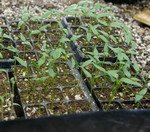 This is shaping up to be the year of the Pepper in my garden at least. A few weeks ago I planted four varieties that I will have in good sized containers by the time they make the garden in early June. Last week I seeded seven more varieties that should be ready in standard cell packs by that planting date. Must never plant Peppers outside too soon. If the weather is cool, the flower buds will be knocked off and it will take that Pepper plant a long time to get back into its flowering cycle. Paradoxically, plant late to get fruit earlier. The earlier planted varieties were transplanted last week from their seedling trays into regular cell packs and will probably stay there until mid May when they should be big enough to move up to bigger pots. The efforts I will go to, in an attempt to have the earliest vegetables and I think I’m having fun.
This is shaping up to be the year of the Pepper in my garden at least. A few weeks ago I planted four varieties that I will have in good sized containers by the time they make the garden in early June. Last week I seeded seven more varieties that should be ready in standard cell packs by that planting date. Must never plant Peppers outside too soon. If the weather is cool, the flower buds will be knocked off and it will take that Pepper plant a long time to get back into its flowering cycle. Paradoxically, plant late to get fruit earlier. The earlier planted varieties were transplanted last week from their seedling trays into regular cell packs and will probably stay there until mid May when they should be big enough to move up to bigger pots. The efforts I will go to, in an attempt to have the earliest vegetables and I think I’m having fun.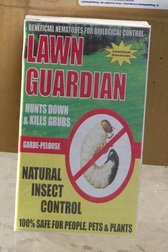 I have ordered my friendly bugs. Well Nematodes aren’t actually bugs but they are friendly. The fine folks at Natural Insect Control sell me several thousand of these wonderful little creatures to set free in the garden to attack the dreaded Iris borer. This year I am also trying a new variety that is going to keep the leaf borer out of my Camperdown Elm and should also work for those of you who have borers making your White Birch trees look unattractive in the summer. They need to be released as soon as the soil temperature is a consistent 50F, (which this spring may be awhile,) so that they are ready to attack as soon as those borers hatch from their overwintering eggs. They also have one this year that might help with a problem that has been showing up in my vegetables. Carrot worm has decided to invade my patch the last couple of years and apparently these nematodes will help with that problem as well.
I have ordered my friendly bugs. Well Nematodes aren’t actually bugs but they are friendly. The fine folks at Natural Insect Control sell me several thousand of these wonderful little creatures to set free in the garden to attack the dreaded Iris borer. This year I am also trying a new variety that is going to keep the leaf borer out of my Camperdown Elm and should also work for those of you who have borers making your White Birch trees look unattractive in the summer. They need to be released as soon as the soil temperature is a consistent 50F, (which this spring may be awhile,) so that they are ready to attack as soon as those borers hatch from their overwintering eggs. They also have one this year that might help with a problem that has been showing up in my vegetables. Carrot worm has decided to invade my patch the last couple of years and apparently these nematodes will help with that problem as well. 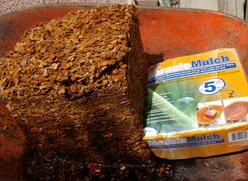 That mulch that I’m trying to refresh in the front gardens is coarse Coconut shell material. It is easily the best mulch I have tried. It looks good, retains its colour and best of all decomposes very slowly so that it lasts for several years. It’s consistently sized pieces set it apart from most of the other wood chip products. They all leave a smattering of large chips on your beds after the smaller pieces have disappeared. I’m going to add some new Coconut shell mulch to beds that were originally done about three years ago and most of that material is still doing its job. If this were a bed that I replanted regularly this long life might be in irritant but in these rather stable perennial beds it’s great. Procrastination has once again proven its benefits. I noticed the blocks of compressed Coconut shell mulch in my local Canadian Tire store a week or so ago and was pleased to see it selling for $5.98, a dollar cheaper than last year. When I finally went back to get some this week it was on sale for $3.98. Procrastination rules!
That mulch that I’m trying to refresh in the front gardens is coarse Coconut shell material. It is easily the best mulch I have tried. It looks good, retains its colour and best of all decomposes very slowly so that it lasts for several years. It’s consistently sized pieces set it apart from most of the other wood chip products. They all leave a smattering of large chips on your beds after the smaller pieces have disappeared. I’m going to add some new Coconut shell mulch to beds that were originally done about three years ago and most of that material is still doing its job. If this were a bed that I replanted regularly this long life might be in irritant but in these rather stable perennial beds it’s great. Procrastination has once again proven its benefits. I noticed the blocks of compressed Coconut shell mulch in my local Canadian Tire store a week or so ago and was pleased to see it selling for $5.98, a dollar cheaper than last year. When I finally went back to get some this week it was on sale for $3.98. Procrastination rules!Those of you who have realised that the front page of of Gardening-enjoyed has a new gardening tip or activity every couple of days at this time of year, may also be happy to see the new Seasonal Advice page where I have started keeping all of this tips so that they are available when they come down from the front page. Questions My newsletter subscribers get to ask me questions. Just ‘reply’ to the email newsletter. It is always interesting to read the questions; mostly to see if I actually can answer them or if I have to wade into the textbooks to research the answers. If that happens then we all learn something. John Asks? Geraniums seem odd food for squirrels. Ever had squirrel damage in your hanging or bed planted geraniums before? And inside a cold frame? Odd. Out of curiosity you might try a couple of small mammal traps. Bait with a mix of peanut butter & oatmeal. You might be surprised at the assortment of secretive small mammals you share the yard with. Interesting, informative and relatively harmless if you simply relocate your captives well away from your property. I suspect your tarring the wrong bandit.?? Ken Answers ! John is a good friend who keeps me on my toes with his biological knowledge. He was responding to my complaints about the squirrels eating my Geraniums. Haven’t tried any traps yet but still might as now the cabbage plants are disappearing. Thank John. Joyce Asks? Now that spring has sprung, I've discovered that the bunny rabbits have feasted all winter on my shrubbery! They stripped bare the dwarf burning bush and also munched on my "pink beauty potentilla." I believe my tulip buds are next. Any advice on how to deter these rabbits? Ken Answers! See John’s advice above. Although I believe you could trap and move and endless number of rabbits. There are several commercial products such as “coyote urine” available that have an odour that is supposed to deter rabbits. They all have some effect. An active dog loose in your yard can also be quite beneficial although its rabbit chasing activities might do as much damage as the rabbits. Ann Asks? I started my Geraniums from seed and all are doing extremely well under my grow lights. I am slowly running out of room and am wondering if I can take these starters and place them in a sunny window. They are approximately 4 " in height. I am concerned that they will become "leggy". I have a small green house that I put out each Spring but it is a little too early to use at this time. Ken Answers! South and West window sills are great sources of light except that it is unidirectional. Your Geraniums will do fine there as long as you are prepared to turn them very day, so that they don’t turn and grow toward the light. Laurie Asks? I have an elephant ears bulb I’ve been saving and growing for a few years now. It has gotten large and unwieldy. Can the bulb be split in some way so I can grow more of them? Ken Answers! Yes, it is possible to divide it. It is technically a tuber, like a potato, and can be chopped into smaller pieces as long as each piece has a couple of growing points. Jane Asks? I was wondering if you've tried growing Rapini (aka broccoli rabe). I got some seeds from Renee's, but I have a feeling it would be happier growing in a Mediterranean climate like California than here. And since none of my rapini-loving Italian neighbours grow it, maybe it doesn't make sense. Ken Answers! I grow Rapini every year. It is a cool weather crop and the little plants are sitting in my cold frame waiting for the first chance to get into the garden. It will bolt quickly in warm weather or if it is not picked quickly enough. Irene & Don Ask? We enjoyed your talk at Canada Blooms and are currently receiving Dallying in the Dirt and check your website regularly. It is very encouraging, especially for novice gardeners. Actually, we've been at it for some 20 yrs but feel like we're just scratching the surface - no pun intended. Would you be so kind as to recommend a good eating variety of pole bean. We purchased McKenzie Kentucky Wonder Wax Bean Pole but want to make sure it is tasty before we invest precious time and real estate for this vegetable. Ken Answers? While the bean you have chosen is worth the real estate, there are better ones. Renee’s Seeds lists a few, all of which are good. For limited space get her tricolour pack with three different pole beans in one seed package. Lynn Asks? I recently bought a beautiful blue hydrangea. How do I keep it blue? How much light does it need? I've read that adding aluminum sulphate, coffee grinds, fruit/veggie peels to the soil can help. Any suggestions? Ken Answers! The blue colour appears when the Hydrangea is growing in an acid soil. Anything that contributes to that acidity such as aluminum sulphate or peat moss, will help to keep it blooming blue. 111 Trent St. W. Whitby ON L1N1L9 |
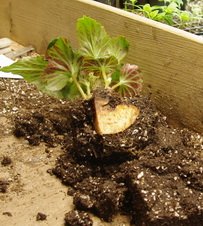 All of the other Tuberous Begonias are also putting up a great quantity of shoots. Very soon I will be brave and take the larger ones and cut them in half. I did this with great success on the large pendulous yellow one last year and now feel confident enough to do some others this year. Not Cordelia, although I will try taking another cutting from her later in the summer. I simply take each large tuber, now that I can see its growing points, cut right through that tuber so that each piece has a few growth points, dust the cut edge with some powdered sulphur and then repot each piece in a separate pot. The only problem with this horticultural success is, now I have twice as many plants to find homes for and to take care of all year. Such a problem.
All of the other Tuberous Begonias are also putting up a great quantity of shoots. Very soon I will be brave and take the larger ones and cut them in half. I did this with great success on the large pendulous yellow one last year and now feel confident enough to do some others this year. Not Cordelia, although I will try taking another cutting from her later in the summer. I simply take each large tuber, now that I can see its growing points, cut right through that tuber so that each piece has a few growth points, dust the cut edge with some powdered sulphur and then repot each piece in a separate pot. The only problem with this horticultural success is, now I have twice as many plants to find homes for and to take care of all year. Such a problem.